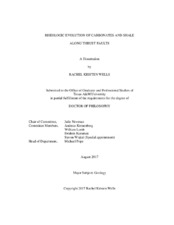| dc.description.abstract | Carbonates and shales are an integral component of fold-and-thrust belts. Deformation processes that control the rheology of these faults are influenced by internal and external conditions. To understand how these processes influence fault zone morphology, I examine 1) the evolution of a fault zone with evidence of variable slip rates, 2) the processes that contribute to the formation of a crystallographic fabric in fine-grained dolomite, and 3) the variables that influence the location of, and displacement along, carbonate-shale thrusts.
Evidence for variable slip rates is preserved along the Copper Creek thrust, as well as overprinting relationships suggesting episodic instability. Nanograins, vesicular calcite, and coated clasts indicate unstable slip and overprint calcite grains with interpenetrating grain boundaries and four-grain junctions suggesting aseismic creep. Based on cross-cutting relationships, we propose a sequence of deformation events consistent with episodic unstable slip.
While a crystallographic fabric in carbonates has been commonly attributed to dislocation creep, a weak fabric is common in fine-grained dolomites that deformed under conditions consistent with diffusion creep. I examine the mechanisms that contribute to the development of a fabric in experimentally and naturally deformed dolomites. Fine-grains that exhibit a weak fabric, four-grain junctions, and subgrains indicate dislocation and diffusion creep. Fine-grains that exhibit a stronger crystallographic fabric and subgrains indicate dislocation creep.
Several thrust sheets within the foreland of the Southern Appalachians contain dolomite along the base of the sheet. The locations of the Copper Creek and Town Knobs thrusts correlate with fracturing of the base at the dolomite that allowed infiltration of fluids and precipitation of veins. The Copper Creek thrust contains calcite veins that deformed by a combination of plasticity-induced fracturing and diffusion creep, resulting in a large displacement along a weak shear zone. In contrast, the Town Knobs thrust contains a dolomite, calcite, and silt shear zone that exhibits evidence for diffusion creep, dislocation creep, and cataclasis. These deformation mechanisms in these minerals did not accommodate as large a displacement along this fault, suggesting that increasing stress at a constant strain rate, or increasing strain rate at constant stress conditions, may have resulted in less displacement. | en |


